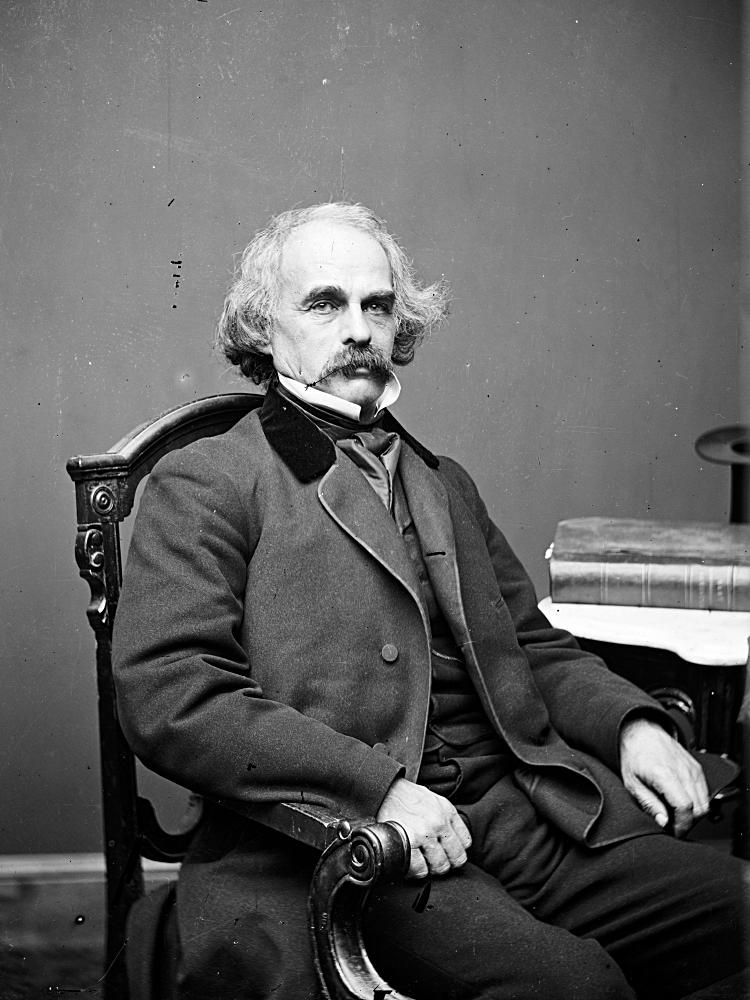Fred Heath
Eng 48A
Journal on Hawthorne
10/6/09
Nathaniel HawthorneEng 48A
Journal on Hawthorne
10/6/09
1804-1864

"Why do you tremble at me alone? Tremble also at each other! Have men avoided me, and women shown no pity, and children screamed and fled only for my black veil? What but the mystery which it obscurely typifies, has made this piece of crape so aweful? When the friend shows his inmost heart to his friend; the lover to his best-beloved; when men does not vainly shrink from the eye of his creator, loathsomely treasuring up the secret of his sin; then deem me a monster, for the symbol beneath which I have lived and die! I look around me and lo, on every visage a black veil!" (pg 1320 Norton)
Sitting up from his deathbed, Father Hooper thus gives his final sermon to the people of Milford. Although open to endless interpretation, as Hawthorn no doubt wanted it, I find that the preacher's words demonstrate that he had a specific purpose in wearing the ominous black veil. After declaring that all men, hide their innermost heart from friends, lovers, and even from God, he describes the veil as a symbol. Hooper, gives the readers no simple answers, withholding the meaning of the veil, but at the same time, is conscious of it's presence, implying that the symbol is meant to be understood. In doing so, he keeps the veil a mystery, forcing the people of Milford, and the readers to form their own opinion.
"In the depths of every heart there is a tomb and a dungeon, though the lights, the music, and revelry above ma
 y cause us to forget their existence, and the buried ones, or prisoners whom they hide. But sometimes, and oftenest at midnight, these dark receptacles are flung wide open. In an hour like his....pray that your griefs may slumber." (The Haunted Mind)
y cause us to forget their existence, and the buried ones, or prisoners whom they hide. But sometimes, and oftenest at midnight, these dark receptacles are flung wide open. In an hour like his....pray that your griefs may slumber." (The Haunted Mind)Exemplifying Hawthorne's interest in the darker recesses of the heart and mind, this quote shows Hawthornes opinion that all men have a dark 'tomb' hidden beneath the veil of normalcy.
Perhaps 'The Ministers Black Veil' is an allegory for mankinds inability to express it's innermost self. Throughout Hawthorne's tale, Father Hooper's veil is the subject of fear, a mystery empowered by the imaginations of the onlookers that bestow meaning to it's obscurity. In many ways, I find that it represents the dark secrets that all of man hides beneath the surface. It is only an object reflective of the 'sins' that it's audience carries within, an object that is fueled by imagination, and natural fear of the unknown. The black veil alone, is nothing more than thin cloth, but upon the face of a man, it becomes a dark mystery; an instrument used to hide the monster that lies beneath, the monster that lives in our own minds.
Another perspective that may be attributed from this reading is Lincoln's Biblical reference 'Judge not, lest ye be judged.' Hooper is feared and harshly judged by a people that assume the worst of him, driven to judgment by their own imagination. They fear the mystery of what hides beneath the black crape. In Hooper's final sermon, however, he tells the people not to fear him, but to fear themselves, ending with the powerful statement: "I look around me and lo, on every visage a black veil!" Perhaps he is saying that all men hide their 'sins' beneath a mask, be it a mask of crape, or flesh, and that the true purpose of the black veil, is to remind them of the darkness that lies within. A very religious statement. In other words: Feel guilty, very guilty.
20 points. I liked that "haunted mind" quote you dug up :)
ReplyDelete